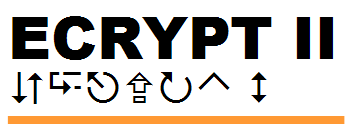NaCl: Networking and Cryptography library

Computer Aided Cryptography Engineering

ECRYPT II
NaCl: Networking and Cryptography library |
 Computer Aided Cryptography Engineering |
 ECRYPT II |
|
InternalsAre you contributing code to NaCl? Here's some advice on how to write your code.Language choiceAll NaCl functions are distributed as C implementations, often with assembly-language implementations as extra options. C++ and Python are handled as wrappers around the C implementations.There are an increasing number of cases where the C implementations and assembly-language implementations are automatically generated from code that was actually written in another language, such as CAO or qhasm. This automatic generation takes place as part of creating the NaCl distribution, not as part of installing NaCl. Naming conventions: an exampleThe reference SHA-512 implementation in NaCl is crypto_hash/sha512/ref/hash.c, which defines a crypto_hash function as follows:
#include "crypto_hash.h"
int crypto_hash(unsigned char *out,const unsigned char *in,unsigned long long inlen)
{
...
}
An accompanying file
crypto_hash/sha512/ref/api.h
says
#define CRYPTO_BYTES 64
to indicate that this function produces a 64-byte hash.
The NaCl compilation scripts automatically create crypto_hash.h with various macros, including the following:
#define crypto_hash crypto_hash_sha512
#define crypto_hash_sha512 crypto_hash_sha512_ref
#define crypto_hash_BYTES crypto_hash_sha512_BYTES
#define crypto_hash_sha512_BYTES crypto_hash_sha512_ref_BYTES
#define crypto_hash_sha512_ref_BYTES 64
#define crypto_hash_PRIMITIVE "sha512"
#define crypto_hash_IMPLEMENTATION crypto_hash_sha512_IMPLEMENTATION
#define crypto_hash_sha512_IMPLEMENTATION "crypto_hash/sha512/ref"
This means that hash.c actually defines a crypto_hash_sha512_ref function.
Normally, as an implementor, you don't have to think about this;
but if you avoid including crypto_hash.h
(for example, because you're actually writing hash.s instead of hash.c)
then you should make sure to define crypto_hash_sha512_ref.
Multiple implementations of the same primitiveTo add another SHA-512 implementation, create another subdirectory of crypto_hash/sha512. For example, you might choose crypto_hash/sha512/core2 for an implementation optimized for the Core 2. Inside that subdirectory, create an api.h file that defines CRYPTO_BYTES, and a .c file that defines crypto_hash.You can use names other than hash.c. You can split your code across several files *.c defining various auxiliary functions; the files will be automatically compiled together. You can use external names prefixed by the implementation name: for example, crypto_hash/sha512/core2 can define crypto_hash_sha512_core2_iv, crypto_hash_sha512_core2_expand, etc. BranchesDo not use secret data to control a branch. In particular, do not use the memcmp function to compare secrets. Instead use crypto_verify_16, crypto_verify_32, etc., which perform constant-time string comparisons.Even on architectures that support fast constant-time conditional-move instructions, always assume that a comparison in C is compiled into a branch, not a conditional move. Compilers can be remarkably stupid. Array lookupsDo not use secret data as an array index.Early plans for NaCl would have allowed exceptions to this rule inside primitives specifically labelled vulnerable, in particular to allow fast crypto_stream_aes128vulnerable, but subsequent research showed that this compromise was unnecessary. Dynamic memory allocationDo not use heap allocators (malloc, calloc, sbrk, etc.) or variable-size stack allocators (alloca, int x[n], etc.) in C NaCl.Thread safetyDo not use global variables (i.e., static variables or variables defined outside functions) in C NaCl.AlignmentDo not assume that the input arrays or output arrays have any particular alignment. If you want to use, e.g., an aligned 16-byte load instruction for speed, check at the top of your function that the input array is properly aligned, and have a (slower) fallback in case the input array is not properly aligned.Specific integer sizesIf you want a 32-bit integer in C NaCl, use crypto_int32 after #include <crypto_int32.h>. This is more portable than int32_t from inttypes.h, and more portable than int32_t from stdint.h. Similar comments apply to crypto_int8, crypto_int16, crypto_int32, crypto_int64, crypto_uint8, crypto_uint16, crypto_uint32, crypto_uint64.Variable definitionsDefine stack variables at the beginning of each function in C NaCl. Some C compilers will accept variable definitions after statements, but some won't.CommentsDo not use C++-style comments (double slashes) in C NaCl. Some C compilers will accept these comments, but some won't.VersionThis is version 2011.06.26 of the internals.html web page. |